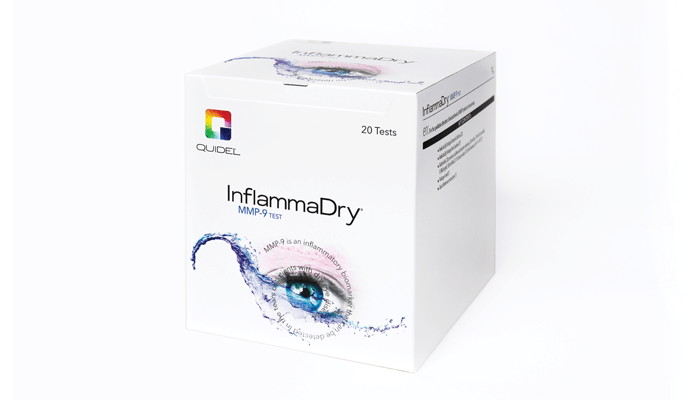
Dry eye disease affects at least 16 million Americans and is one of the leading reasons for people choosing to visit eye care professionals (1). Although extremely common, this medical condition can have serious consequences for ocular health – especially in cases that are not detected early.
Now, there is a new breakthrough from QuidelOrtho, called InflammaDry, that detects increased levels of MMP-9 – an inflammatory marker that is consistently elevated in the tears of patients with inflammatory dry eye disease. Notably, InflammaDry is the first and only rapid, in-office test able to give insight on this important biomarker.
The advantages of using InflammaDry are two-fold. First, point- of-care testing enables more rapid diagnosis of dry eye disease, which gives patients early information about their prognosis. Second, point-of-care testing not only informs treatment choice but also allows clinicians to monitor progress using a given therapeutic, both of which facilitate operational decision making and efficient resource utilization.
Beyond QuidelOrtho, a number of leading voices are highlighting the importance of ocular inflammation. For example, the Tear Film and Ocular Society Dry Eyes Workshop report of 2017 recognized ocular inflammation’s central role in the loss of ocular homeostasis (2). And, in a move that acknowledges the importance of early detection, the ASCRS Cornea Committee developed a new algorithm for pre-op evaluations for ocular surface disease (OSD). (3) Notably, InflammaDry was integrated into this new protocol as an essential resource to maximize pre-operative to post-op outcomes. In short, InflammaDry can be an enormously useful tool for cataract, refractive or corneal specialists who need to monitor ocular inflammation as part of surgical care.
Identifying which symptomatic dry eye patients have underlying inflammation may predict patient responses to treatment and influence clinical and therapeutic management strategies.
QuidelOrtho Corporation’s power is fueled by a shared mission of developing and manufacturing innovative technologies that raise the performance of diagnostic testing and create better patient outcomes across the entire healthcare continuum.
InflammaDry is available in the US, Canada, South America, Europe, and South Korea.
References
- “Dry Eye”, National Eye Institute. Available at http://bit.ly/3OaS4K9.
- Tear Film and Ocular Surface Society, Dry Eyes Workshop report. Availableat http://bit.ly/3gfj26O.
- Christopher E. Starr, et. al,. “An algorithm for the preoperative diagnosis and treatment of ocular surface disorders.” Journal of Cataract & Refractive Surgery, Vol. 45, p 669, (2019).
